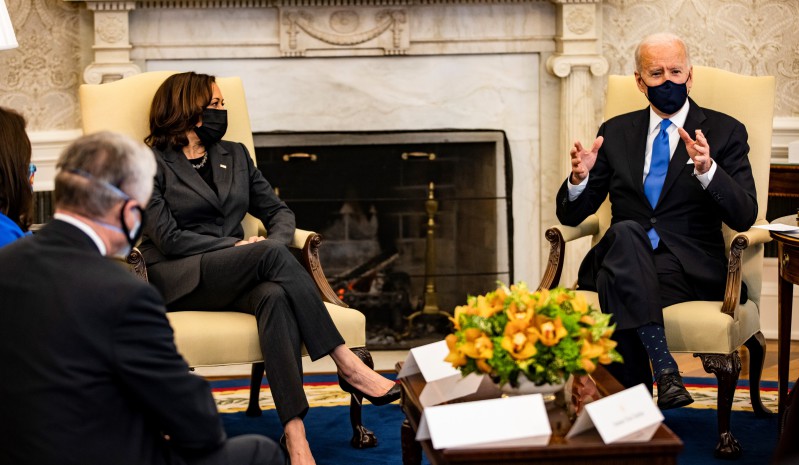
President Trump’s last executive actions and President Biden’s early ones reveal fleeting nature of executive power.
President Joseph R. Biden has launched his Administration with a pace of formal executive initiative not seen since the New Deal. Pages and pages of public “executive actions”—taking the various forms of executive orders, proclamations, or presidential memoranda—have signaled profound changes in policy from his predecessor. Congressional Republicans lost no time in alleging an inconsistency between President Biden’s exhortations to unity and his running start with executive action in so many areas. But Democrats have pointed to widespread public support for President Biden’s commitments—support apparently unifying voters well beyond the Democratic base.
The body of presidential initiatives emerging so quickly from the Biden White House is instructive, however, about more than just the ambitions of one particular President. These executive initiatives also provide important clues as to both the reach and limitations of presidential power. Such lessons emerge yet more pointedly when President Biden’s opening flurry of actions is viewed in tandem with the closing burst from President Donald J. Trump.
Looking at President Biden’s first week against the backdrop of President Trump’s last actually points to some important lessons about the powers and frustrations of the contemporary presidency.
The immediate public impacts of executive action are mostly symbolic. In the great majority of cases, executive orders, proclamations, and presidential memoranda have no direct, immediate consequences for the legal rights or responsibilities for anyone outside the government. Instead, presidential actions typically set in motion some further government activity that may eventually produce the public impacts a President desires. The most apparent public impact of most executive “actions” is thus to underscore, implicitly or explicitly, what Presidents take to be their Administrations’ core values or policy priorities.
In his last week in office, President Trump signed fewer than two dozen published “executive actions,” but they hit nearly all of the high—or, depending on your perspective, low—notes of President Trump’s agenda, including tough stances on China, law enforcement, and immigration, as well as opposition to abortion and support for school choice.
Two executive orders were intended to further President Trump’s ideas of regulatory reform. One would limit the initiation of major regulatory activity to an agency’s senior political officials, who would also be the only persons entitled to sign off on final rules.
Another would carefully delimit the circumstances under which agencies would seek to impose criminal penalties for regulatory violations. These orders are puzzling chiefly because it is not clear in either order whether President Trump responded to a significant problem or altered the way agencies had previously done business. They signal, however, the value President Trump placed on the political chain of command and leniency in holding rule violators accountable.
Among President Trump’s final executive orders is one that explicitly addresses matters of symbolism, namely, Executive Order 13978, “Building the National Garden of American Heroes.” In the order, President Trump commands the Secretary of the Interior to provide funding for a “beautiful new garden … to reflect the awesome splendor of our country’s timeless exceptionalism.”
President Trump cast the “hero garden” order as a counterattack against unpatriotic assaults on monuments to great Americans: “When the forces of anti-Americanism have sought to burn, tear down, and destroy, patriots have built, rebuilt, and lifted up.” The order’s most remarkable section is a list of 244 individuals for whom new statues were to be created. It reads like the answer to future trivia questions, such as, “What do Whittaker Chambers and Alex Trebek have in common?” or “Where are Walt Disney and Frederick Douglass both memorialized?”
Another Trump order that, perhaps ironically, had the most immediate impact is Executive Order 13983, which was issued on President Trump’s last full day in office. Its sole operational provision was the revocation of Executive Order 13770, an order issued eight days into the Trump Administration which specified the ethical obligations President Trump would impose on his executive appointees. The seeming intent of President Trump’s last-minute order was presumably to relieve appointees of their earlier commitments. But the 2017 order was itself a revocation of President Barack Obama’s yet more stringent order on conflicts of interest from 2009. Read literally, President Trump’s later order thus poses the question, whether the 2021 revocation of a 2017 revocation now subjects Trump Administration appointees to the 2009 Obama requirements previously revoked. In any event, President Biden’s first-day executive orders included his own set of ethical requirements for executive branch appointees.
In total, President Biden’s first week occasioned the issuance of 23 executive orders, two proclamations, and eight presidential memoranda. Like President Trump’s final initiatives, these signal the policy priorities of their signatory, echoing the themes of Biden’s campaign: responding to the COVID-19 pandemic, addressing racial and gender inequities, fighting climate change, and changing direction on immigration policy. President Biden’s first proclamation was to declare January 20, 2021, a “National Day of Unity.” It explicitly echoed the themes of his inaugural address.
Most “executive actions” bind only the executive branch and only in limited, albeit important ways. Because U.S. Presidents have no general decree power, executive actions must draw their authority either from narrower grants of presidential power in Article II of the U.S. Constitution or from statutes enacted by the U.S. Congress. Other than the pardon power, however, Article II grants Presidents virtually no peacetime domestic authority to alter the general public’s legal rights or responsibilities.
What presidents can accomplish unilaterally in domestic affairs by solely relying on Article II power flows almost exclusively from whatever supervisory and coordinating authority over the bureaucracy that they enjoy because they are constitutionally vested with “executive power” and charged with taking care that the laws be faithfully executed. That is why the typical executive action, regardless of format, is actually an assignment of work to subordinate administrators intended to bear fruit in the months and years ahead.
Of President Biden’s first-week executive orders and proclamations, only about half a dozen appear to be rooted in statutory authority that Congress has vested specifically in the President. These actions include the new order on “Ethics Commitments by Executive Branch Personnel,” portions of the order on “Protecting Public Health and the Environment and Restoring Science to Tackle the Climate Crisis,” and an order on “Protecting the Federal Workforce and Requiring Mask-Wearing.”
Almost all the other first-week executive orders and proclamations instead create new policy coordinating structures and assign high-priority work to cabinet secretaries and others. These orders are quite specific about President Biden’s medium- and long-term objectives, but the assignments they convey do not explicitly curtail his subordinates’ legal discretion under whatever statutes Congress has charged them to implement.
For example, in President Biden’s very first order, “Advancing Racial Equity and Support for Underserved Communities Through the Federal Government,” the President assigns the Director of the Office of Management and Budget a variety of tasks to “identify” best practices, “consider” recommendations, and “assess” existing policies. These tasks and similar activities assigned to others are intended to yield plans to address the order’s objectives. The details of implementation are necessarily left for future elaboration.
Assignments to “review,” “consider,” “assess,” “report,” and the like are also conspicuous elements of other Biden orders such as those entitled “Preventing and Combating Discrimination on the Basis of Gender Identity or Sexual Orientation,” “Revision of Civil Immigration Enforcement Policies and Priorities,” “Protecting Worker Health and Safety,” and “A Sustainable Public Health Supply Chain.”
To the extent that President Biden seeks to instigate more direct agency action, he typically orders agencies receiving his assignments to act as is “appropriate and consistent with applicable law,” leaving primary discretion in implementation to the agencies. Examples include the orders entitled “Improving and Expanding Access to Care and Treatments for COVID-19,” “Promoting COVID-19 Safety in Domestic and International Travel,” and “Economic Relief Related to the COVID-19 Pandemic.”
The main significance of first-week orders of this type rests not on any direct improvement in COVID-19 response, the mitigation of climate change, or greater equity in the administration of government programs. What makes these first-week orders powerful is their inevitable impact on the time and attention of federal administrators in the coming weeks, months, and years. The sheer number of assignments to specific departments and agencies will necessarily have dramatic impacts on the allocation of staff time and resources throughout the executive establishment.
Executive agenda-setting power is reinforced by the many new consultative structures that President Biden’s orders create. In just his first week, President Biden assigned a large number of existing federal officers to 11 new administrative bodies, whether called working groups, task forces, boards, or councils. They will focus on issues relating to the COVID-19 response, racial equity in government programs, global health security and biodefense, federal workforce safety, climate policy (including economic revitalization in coal communities), and scientific integrity.
By executive order, President Biden has also created new positions within the White House including a COVID-19 Response Coordinator and Counselor to the President, and a Senior Director for Global Health Security and Biodefense working with the National Security Council (NSC).
The scarcest commodity for high-level administrators is time, and these orders foreshadow where the time of high-level policymakers and their staffs will be spent.
Easy come, easy go. It is an intriguing and often overlooked feature of the administrative state that, although Presidents serve for constitutionally limited terms, their executive orders and memoranda do not necessarily lose force when they leave office. For example, the executive branch still follows President Ronald Reagan’s executive actions on the organization of intelligence activities and on the process for dealing with potential executive privilege claims against Congress. The White House continues to review proposed agency regulations under an executive order President Bill Clinton signed in 1993.
There are, however, no formal procedural steps that presidents need to take in issuing their own, new executive orders, proclamations, and memoranda—even ones repealing earlier executive orders. Whatever one President creates with a stroke of the presidential pen can be revoked just as summarily.
A conspicuous feature of President Biden’s first-week executive actions is the sheer number of Trump executive actions they explicitly revoke. Among the Trump initiatives revoked are executive orders and memoranda establishing a “1776 Commission,” asking individuals about their citizenship status as part of the 2020 census, allowing oil drilling in the Arctic Refuge lands, disciplining “sanctuary jurisdictions,” and setting forth President Trump’s vision for the President’s Council of Advisors on Science and Technology.
One Biden order revoked a dozen Trump Administration orders and memoranda on environmental policy. One revoked half a dozen Trump orders on federal regulatory processes. Another revoked five Trump initiatives on the federal workforce, including the intended creation of a civil service Schedule F, which threatened to significantly politicize the federal bureaucracy. Another revoked or limited the impact of five Trump initiatives on government purchasing. Of both immediate practical and symbolic significance, President Biden, in his first week, also revoked both the Trump travel ban order and the March 2019 permit for the Keystone XL pipeline.
President Biden took an ax even to executive actions President Trump issued in his final week. Five days before leaving office, President Trump officially announced the continuation of a national emergency over the U.S. southern border. President Biden terminated the emergency declaration on Inauguration Day.
Six days before leaving office, President Trump issued a directive on the “Buy American” policies applicable to the United States Postal Service. That order lasted five days into the Biden Administration. Among President Trump’s few initiatives rooted in specific statutory authority was a proclamation on his last full day in office on “Adjusting Imports of Aluminum into the United States.” Technically, that proclamation did survive President Biden’s first week—he did not revoke and replace it until February 1.
Institutionally, perhaps the most curious feature of President Trump’s final week of output is the frequency with which he issued orders purporting to set up structures and to demand reports and plans extending well beyond the end of his term.
This behavior is not entirely unheard of. President George W. Bush, during his final week in office, established a U.S. Department of Defense working group for strengthening biosecurity. President Obama, with about six weeks left to go, issued a memorandum directing the key departments and agencies involved in protecting national security to “prepare for the President a formal report that describes key legal and policy frameworks that currently guide the United States use of military force and related national security operations, with a view toward the report being released to the public.” President Obama further ordered NSC staff to update and release such a report annually.
Yet President Trump’s initiatives stand out for the greater frequency with which he appeared to issue directions to administrators no longer under his supervision. For example, he directed the Attorney General, by February 17, 2021, to propose a regulation that would permit federal prosecutors concerned about the risk of harm to themselves or to their families to be given special deputations within the U.S. Marshal Service that would enable them to carry firearms. President Trump also directed the Attorney General to “develop and propose federal legislation providing additional protection for judges, prosecutors, and law enforcement officers.”
With two days left in his term, President Trump purported to order the Administrator of the Federal Aviation Administration to propose regulation “within 270 days” on the use of unmanned aircraft systems. On President Trump’s last full day of office, he purported to give the Secretary of Defense a year to “conduct a rigorous study investigating toxic exposure by members of the Armed Forces” deployed in Uzbekistan.
It remains to be seen whether these assignments will be fulfilled, modified, revoked, or just ignored—not to mention, of course, the Trump directive to finance the creation of those 244 statues to be placed in a National Garden of American Heroes.
This essay is the first part of a two-part feature on President Biden’s early “executive actions” and presidential authority. Part two appears as “Shaping Administrative Process and Metrics of Ambition.”




